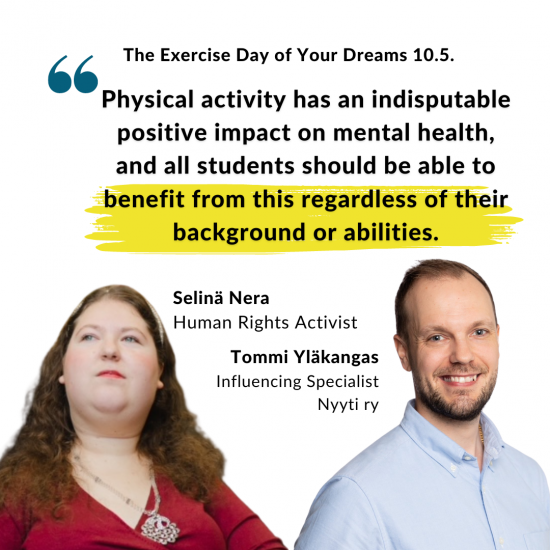The Exercise Day of Your Dreams: exercise is for everyone
Physical activity has an indisputable positive impact on mental health, and all students should be able to benefit from this regardless of their background or abilities, according to human rights activist Selinä Nera and Tommi Yläkangas, Influencing Specialist at Nyyti ry. The university sector is currently offering a wide variety of sports services for students, but is exercise for everyone if all students don’t have equal access to these activities?

There are many situations in university sports where participation is impeded by the accessibility challenges that some students face. We are on our way towards safer university sports, but the active participation in sports of students with various backgrounds has not always been taken into account. This can easily lead to situations where structural discrimination reduces people’s opportunities to become part of a community and exercise together. Many of the sports facilities that are more affordable for students are not accessible and have no aids or skills available to offer adapted sports. Accessibility also applies to other user groups – a student who is part of a gender minority might not feel welcome because of the lack of changing rooms, for instance.
A survey which the Finnish Student Sports Federation carried out with the university sports services shows that adapted sports are barely taken into consideration in the planning of services even if the facilities are at least partially accessible. The survey participants said that the explanation for this lies mainly in the lack of resources and training, but many participants were also of the view that there is no need for adapted sports services, or that they at least don’t know what sort of services the students would need. This is an alarming result, as nearly half of the 19–29-year-olds who filled out the physical activity survey (2024) for people with disabilities which was carried out by the Finnish Society of Sport Sciences stated that they want to be more physically active. Just over one in four of the participants stated that the lack of suitable groups stops them from doing sports as a hobby, and one in five couldn’t access the personal assistance they need. The survey results also highlighted the loneliness of the young people: 30 percent of the participants said that they don’t have any friends to share their hobbies with.
Exercise is an important part of wellbeing and coping in terms of improving one’s fitness and health. Exercise helps people maintain their functional abilities, which is particularly important for stressed students – with or without disabilities.
To make exercise and sport possible for everyone, regardless of their background, those who are providing sports services need to be trained in diversity and adapted sports. Being able to borrow various aids for exercise would also make it easier for all students to participate on an equal basis. When planning the funding for universities, the resources of sports services and potential collaborations with organisations offering aids should be taken into account. It is also important to invest in communication about adapted sports and accessibility information.
Physical activity also improves mental health. Recent studies have shown that in addition to improving mood, physical activity reduces depressive symptoms so strongly that exercise should become an integral part of mental health services. It is important that everyone should genuinely have access to these benefits that exercise has to offer.
Today, the 10 of May, is the Exercise Day of Your Dreams, and we want to remind people that the joy of exercise is for everyone, now and in the future. We want to encourage all to consider how students with different abilities have been taken into consideration in the sports services, and how the situation could be improved by working with different organisations.
Sources:
Prinkey, V. & Roitto, R. (toim.) 2024. Liikuttaako 2023? Toimintarajoitteisille henkilöille suunnatun Liikkujakyselyn ja Seura- ja yhdistyskyselyn raportti. Liikuntatieteellisen Seuran tutkimuksia ja selvityksiä 26.
You may also be interested in
-
Joko puhutaan liikkumisesta? Opiskelijoiden Liikuntaliitto vaatii vaalitavoitteissaan konkreettisia toimia liikunnan edistämiseksi
Published:Mikä toimiala on 1) miljardien arvoinen, 2) kaikkien poliitikkojen suosiossa ja 3) lähes näkymätön vaalikeskusteluissa? Kyse on liikkumisen ja liikunnan edistämisestä. Opiskelijoiden Liikuntaliiton (OLL) kunnianhimoisena tavoitteena onkin tuoda korkeakoululiikunta kevään eduskuntavaalikeskusteluihin.
-
Advocacy pays off: One million euros for promoting sports and physical activity in higher education
Published:The Finnish Student Sports Federation (OLL) is pleased with the funding of the Finland on the Move programme for higher education institutions. In April 2024, the Ministry of Education and Culture will provide a state grant for the academic year 2024–2025 to a maximum value of one million euros for the implementation of the Students on the Move programme in higher education institutions.
-
Gender minorities' experience of university sports leave room for improvement
Published:What kind of experiences do LGBTQIA+ people have of university sports? How could we improve the experiences of gender minorities? In this article, Finnish Student Sports Federation’s Secretary General Niko Peltokangas takes a look into the results of the Student Barometer 2022 survey from a minority sports perspective.
Share this page
Page last updated 24.5.2024
